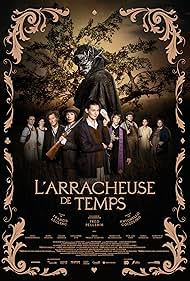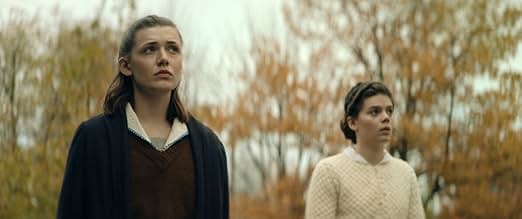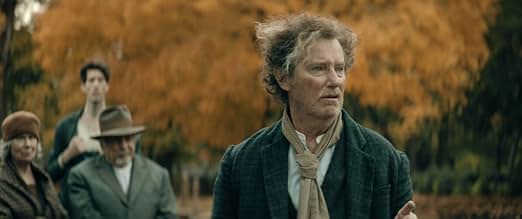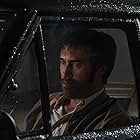Aggiungi una trama nella tua linguaIn 1988, in Saint-Élie-de-Caxton, an eleven-year-old boy worries about his grandmother's life. Exhausted by illness, the ancient storyteller tries to convince her grandson that Death no long... Leggi tuttoIn 1988, in Saint-Élie-de-Caxton, an eleven-year-old boy worries about his grandmother's life. Exhausted by illness, the ancient storyteller tries to convince her grandson that Death no longer exists.In 1988, in Saint-Élie-de-Caxton, an eleven-year-old boy worries about his grandmother's life. Exhausted by illness, the ancient storyteller tries to convince her grandson that Death no longer exists.
- Premi
- 4 vittorie e 14 candidature
Trama
Recensione in evidenza
L'Arracheuse de temps is a tale written by Canadian musician and storyteller Fred Pellerin that was adapted as a movie featuring numerous well-known actresses and actors from the Province of Quebec. The story takes place in the year 1988 and revolves around eleven-year old Fred who is growing up in rural municipality Saint-Élie-de-Caxton. He spends much time with his grandmother Bernadette whose medical condition is getting worse. In order to reassure her grand-son that nothing bad will happen to her, she tells him how she witnessed the death of Death itself as a teenager in her little town all the way back in 1927.
The movie transitions back and forth between these two timelines but strongly focuses on the past events. Teenage girl Bernadette observes how the apple tree in front of the church is hit by lightning in the middle of the night. She sees a strange creature roaming around the tree and soon comes to the conclusion that it must be Death. The next day, people in town discover that the apples from the tree have all turned black and discuss what should be done with the tree and its apples. One of Madame Gélinas' children eats several of these apples and gets very sick. Bernadette visits a mysterious woman known as La Stroop who is living on an isolated farm to ask her for help. The mysterious lady gives her some sort of medication to save the sick child but Bernadette arrives a few minutes too late and witnesses Death in the somber corridors of the Gélinas house. Bernadette realizes that her best friend Lurette also ate an apple and tries to save her as well as several other people in town. However, she quickly realizes that she has to set a trap for Death and murder it with the help of La Stroop to save her community.
This movie convinces on several levels. First of all, the location of Saint-Élie-de-Caxton wonderfully represents what the Province of Quebec looked like in its rural settlements throughout the first half of the twentieth century. The different characters in this film are also particularly charming such as the drunk barber who learns that he will die in three days, the young priest who has gotten a terribly ridiculous haircut but still tries to transmit his gloomy messages with conviction or the local merchant who is trying to make money by selling people only one boot or offering one sad bottle of beer as reward for a tournament in his establishment for the entire community. The film also oozes with atmosphere as one discovers the magic potions and tricks of the intriguing La Stroop or the hiding spot of Death on the local graveyard.
The movie however isn't without its flaws. The story is overall rather weak, predictable and not gripping enough to carry the film throughout almost two hours. Several parts of the movie have significant lengths and barely develop the characters. The movie also fails to find a balance between humorous parts and sinister sections and offers an odd mixture of comedy, fantasy and horror elements with much folklore.
At the end of the day, L'Arracheuse de temps is interesting for those interested in Quebec's culture, history and literature. It's the kind of movie drama class, history class and French class teachers might find intriguing while half of the students might be happy to get to watch such a movie while the other half will fall asleep halfway through the film. The film's saving grace is that it's out of the box by combining old-fashioned storytelling with contemporary production values.
The movie transitions back and forth between these two timelines but strongly focuses on the past events. Teenage girl Bernadette observes how the apple tree in front of the church is hit by lightning in the middle of the night. She sees a strange creature roaming around the tree and soon comes to the conclusion that it must be Death. The next day, people in town discover that the apples from the tree have all turned black and discuss what should be done with the tree and its apples. One of Madame Gélinas' children eats several of these apples and gets very sick. Bernadette visits a mysterious woman known as La Stroop who is living on an isolated farm to ask her for help. The mysterious lady gives her some sort of medication to save the sick child but Bernadette arrives a few minutes too late and witnesses Death in the somber corridors of the Gélinas house. Bernadette realizes that her best friend Lurette also ate an apple and tries to save her as well as several other people in town. However, she quickly realizes that she has to set a trap for Death and murder it with the help of La Stroop to save her community.
This movie convinces on several levels. First of all, the location of Saint-Élie-de-Caxton wonderfully represents what the Province of Quebec looked like in its rural settlements throughout the first half of the twentieth century. The different characters in this film are also particularly charming such as the drunk barber who learns that he will die in three days, the young priest who has gotten a terribly ridiculous haircut but still tries to transmit his gloomy messages with conviction or the local merchant who is trying to make money by selling people only one boot or offering one sad bottle of beer as reward for a tournament in his establishment for the entire community. The film also oozes with atmosphere as one discovers the magic potions and tricks of the intriguing La Stroop or the hiding spot of Death on the local graveyard.
The movie however isn't without its flaws. The story is overall rather weak, predictable and not gripping enough to carry the film throughout almost two hours. Several parts of the movie have significant lengths and barely develop the characters. The movie also fails to find a balance between humorous parts and sinister sections and offers an odd mixture of comedy, fantasy and horror elements with much folklore.
At the end of the day, L'Arracheuse de temps is interesting for those interested in Quebec's culture, history and literature. It's the kind of movie drama class, history class and French class teachers might find intriguing while half of the students might be happy to get to watch such a movie while the other half will fall asleep halfway through the film. The film's saving grace is that it's out of the box by combining old-fashioned storytelling with contemporary production values.
I più visti
Accedi per valutare e creare un elenco di titoli salvati per ottenere consigli personalizzati
- How long is L'Arracheuse de temps?Powered by Alexa
Dettagli
- Data di uscita
- Paese di origine
- Lingua
- Celebre anche come
- La mietitrice del tempo
- Luoghi delle riprese
- Saint-Armand, Quebec, Canada(General store)
- Azienda produttrice
- Vedi altri crediti dell’azienda su IMDbPro
Botteghino
- Lordo Stati Uniti e Canada
- 750.623 USD
- Fine settimana di apertura Stati Uniti e Canada
- 188.790 USD
- 21 nov 2021
- Lordo in tutto il mondo
- 750.623 USD
- Tempo di esecuzione1 ora 45 minuti
- Colore
Contribuisci a questa pagina
Suggerisci una modifica o aggiungi i contenuti mancanti

Divario superiore
By what name was L'Arracheuse de temps (2021) officially released in Canada in English?
Rispondi

















